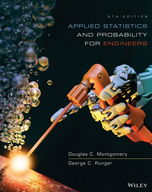Solution Found!
An article in Ad Hoc Networks [“Underwater Acoustic Sensor
Chapter 4, Problem 136E(choose chapter or problem)
An article in Ad Hoc Networks [“Underwater Acoustic Sensor Networks: Target Size Detection and Performance Analysis” (2009, Vol.7(4), pp. 803–808)] discussed an underwater acoustic sensor network to monitor a given area in an ocean. The network does not use cables and does not interfere with shipping activities. The arrival of clusters of signals generated by the same pulse is taken as a Poisson arrival process with a mean of λ per unit time. Suppose that for a specific underwater acoustic sensor network, this Poisson process has a rate of 2.5 arrivals per unit time.
(a) What is the mean time between 2.0 consecutive arrivals?
(b) What is the probability that there are no arrivals within 0.3 time units?
(c) What is the probability that the time until the first arrival exceeds 1.0 unit of time?
(d) Determine the mean arrival rate such that the probability is 0.9 that there are no arrivals in 0.3 time units.
Questions & Answers
QUESTION:
An article in Ad Hoc Networks [“Underwater Acoustic Sensor Networks: Target Size Detection and Performance Analysis” (2009, Vol.7(4), pp. 803–808)] discussed an underwater acoustic sensor network to monitor a given area in an ocean. The network does not use cables and does not interfere with shipping activities. The arrival of clusters of signals generated by the same pulse is taken as a Poisson arrival process with a mean of λ per unit time. Suppose that for a specific underwater acoustic sensor network, this Poisson process has a rate of 2.5 arrivals per unit time.
(a) What is the mean time between 2.0 consecutive arrivals?
(b) What is the probability that there are no arrivals within 0.3 time units?
(c) What is the probability that the time until the first arrival exceeds 1.0 unit of time?
(d) Determine the mean arrival rate such that the probability is 0.9 that there are no arrivals in 0.3 time units.
ANSWER:
Answer
Step 1 of 4
(a)
The arrival of clusters of signals generated by the same pulse is taken as a Poisson arrival process with a mean of
Suppose that for a specific underwater acoustic sensor network, this Poisson process has a rate of
We are asked to find the mean time between consecutive arrivals.
Let denotes the number of arrivals in the given network and this will follows a Poisson arrival process.
The random variable that equals the distance between successive events from a Poisson process with mean number of events
is an exponential random variable with parameter
. The probability density function of
is
……….(1)
We have given hence mean time between
consecutive arrivals is,
Hence the mean time between consecutive arrivals is
